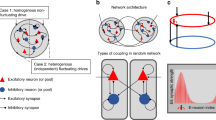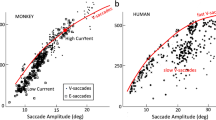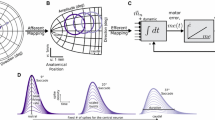Abstract
We present a biologically plausible model of binocular rivalry consisting of a network of Hodgkin-Huxley type neurons. Our model accounts for the experimentally and psychophysically observed phenomena: (1) it reproduces the distribution of dominance durations seen in both humans and primates, (2) it exhibits a lack of correlation between lengths of successive dominance durations, (3) variation of stimulus strength to one eye influences only the mean dominance duration of the contralateral eye, not the mean dominance duration of the ipsilateral eye, (4) increasing both stimuli strengths in parallel decreases the mean dominance durations. We have also derived a reduced population rate model from our spiking model from which explicit expressions for the dependence of the dominance durations on input strengths are analytically calculated. We also use this reduced model to derive an expression for the distribution of dominance durations seen within an individual.
Similar content being viewed by others
References
Abbott LF, Varela JA, Sen K, Nelson SB (1997) Synaptic depression and cortical gain control. Science 275: 220–223.
Andrews TJ, Purves D (1997) Similarities in normal and binocularly rivalrous viewing. Proc. Natl. Acad. Sci. USA 94: 9905–9908.
Blake R (1989) A neural theory of binocular vision. Psychol. Rev. 96: 145–167.
Borsellino A, De Marco A, Allazetta A, Rinesi S, Bartolini B (1972) Reversal time distributions in the perception of visual ambiguous stimuli. Kybernetik 10: 139–144.
Bossink CJH, Stalmeier PFM, De Weert CMM (1993) A test of Levelt's second proposition for binocular rivalry. Vision Res. 33: 1413–1419.
Carlson TA, He S (2000) Visible binocular beats from invisible monocular stimuli during binocular rivalry. Curr. Biol. 10(17): 1055–1058.
Dayan P (1998) A hierarchical model of binocular rivalry. Neural Comput. 10: 1119–1135.
Ermentrout GB (1998) Neural networks as spatio-temporal patternforming systems. Rep. Prog. Phys. 61: 353–430.
Fox R, Herrmann J (1967) Stochastic properties of binocular rivalry alternations. Percept Psychophys. 2: 432–436.
Gomez C, Argandona ED, Solier RG, Angulo JC, Vazquez M(1995) Timing and competition in networks representing ambiguous figures. Brain Cogn. 29: 103–114.
Gutkin BS, Laing CR, Colby CL, Chow CC, Ermentrout GB (2001) Turning on and off with excitation: The role of spike timing in asynchrony and synchrony in sustained neural activity. J. Comput. Neurosci. 11(2).
Hansel D, Sompolinsky H (1998) Modeling feature selectivity in local cortical circuits. In: C Koch, I Segev, eds. Methods in Neuronal Modeling (2nd ed.). MIT Press, Cambridge, MA.
Huguenard JR, McCormick DA (1992) Simulation of the currents involved in rhythmic oscillations in thalamic relay neurons. J. Neurophysiol. 68(4): 1373–1383.
Kalarickal GJ, Marshall JA (2000) Neural model of temporal and stochastic properties of binocular rivalry. Neurocomput. 32: 843–853.
Kovacs I, Papathomas TV, Yang M, Feher A (1996) When the brain changes its mind: Interocular grouping during binocular rivalry. Proc. Natl. Acad. Sci. USA 93: 15508–15511.
Laing CR, Chow CC (2001) Stationary bumps in networks of spiking neurons. Neural Comput. 13: 1473–1494.
Lee S-H, Blake R (1999) Rival ideas about binocular rivalry. Vision Res. 39: 1447–1454.
Lehky SR (1988) An astable multivibrator model of binocular rivalry. Perception 17: 215–228.
Lehky SR (1995) Binocular rivalry is not chaotic. Proc. R. Soc. Lond. B Biol. Sci. 259: 71–76.
Leopold DA, Logothetis NK (1996) Activity changes in early visual cortex reflect monkeys' percepts during binocular rivalry. Nature 379: 549–553.
Leopold DA, Logothetis NK (1999) Multistable phenomena: Changing views in perception. Trends Cogn. Sci. 3(7): 254–264.
Levelt WJM (1968) On Binocular Rivalry. Minor Series 2. Psychological Studies. The Hague: Mouton.
Logothetis NK (1998) Single units and conscious vision. Philos. Trans. R. Soc. Lond. B Biol. Sci. 353: 1801–1818.
Logothetis NK, Leopold DA, Sheinberg DL (1996) What is rivalling during binocular rivalry? Nature 380: 621–624.
Logothetis NK, Schall JD (1989) Neuronal correlates of subjective visual perception. Science 245: 761–763.
Lumer ED (1998) A neural model of binocular integration and rivalry based on the coordination of action-potential timing in primary visual cortex. Cereb. Cortex 8: 553–561.
Lumer ED, Friston KJ, Rees G (1998) Neural correlates of perceptual rivalry in the human brain. Science 280: 1930–1934.
Markram H, Wang Y, Tsodyks M (1998) Differential signaling via the same axon of neocortical pyramidal neurons. Proc. Natl. Acad. Sci. USA 95: 5323–5328.
McCormick DA, Huguenard JR (1992) A model of the electrophysiological properties of thalamocortical relay neurons. J. Neurophysiol. 68(4): 1384–1400.
McCormick DA, Williamson A (1989) Convergence and divergence of neurotransmitter action in human cerebral cortex. Proc. Natl. Acad. Sci. USA 86: 8098–8102.
Mueller TJ (1990) A physiological model of binocular rivalry. Vis. Neurosci. 4: 63–73.
Mueller TJ, Blake R (1989) A fresh look at the temporal dynamics of binocular rivalry. Biol. Cyber. 61: 223–232.
Ngo TT, Miller SM, Liu GB, Pettigrew JD (2000) Binocular rivalry and perceptual coherence. Curr. Biol. 10(4): R134–R136.
O'shea RP (1998) Effects of orientation and spatial frequency on monocular and binocular rivalry. In: N Kasabov, R Kozma, K Ko, R O'shea, G Coghill, T Gedeon, eds. Proceedings of the Fourth International Conference on Neural Information Processing and Intelligent Information Systems. Springer-Verlag, Singapore. pp. 67–70.
O'shea RP, Govan DG, Sekuler R (1997) Blur and contrast as pictorial depth cues. Perception 26: 599–612.
Pettigrew JD, Miller SM (1998) A “sticky” interhemispheric switch in bipolar disorder? Proc. R. Soc. Lond. B Biol. Sci. 265: 2141–2148.
Racicot DM, Longtin A (1997) Interspike interval attractors from chaotically driven neuron models. Physica D 104: 184–204.
Rock I, Hall S, Davis J (1994) Why do ambiguous figures reverse? Acta Psychol. 87: 33–57.
Sheinberg DL, Logothetis NK (1997) The role of temporal cortical areas in perceptual organization. Proc. Natl. Acad. Sci. USA 94: 3408–3413.
Walker P (1975) Stochastic properties of binocular rivalry. Percept Psychophys. 18: 467–473.
Walker P (1976) The perceptual fragmentation of unstabilized images. Q. J. Exp. Psychol. 28: 35–45.
Wang XJ (1999) Synaptic basis of cortical persistent activity: The importance of NMDA receptors to working memory. J. Neurosci. 19(21): 9587–9603.
Wilson HR, Blake R, Lee SH (2001) Dynamics of travelling waves in visual perception. Nature 412: 907–910.
Wilson HR, Krupa B, Wilkinson F (2000) Dynamics of perceptual oscillations in form vision. Nat. Neurosci. 3(2): 170–176.
Author information
Authors and Affiliations
Rights and permissions
About this article
Cite this article
Laing, C.R., Chow, C.C. A Spiking Neuron Model for Binocular Rivalry. J Comput Neurosci 12, 39–53 (2002). https://doi.org/10.1023/A:1014942129705
Issue Date:
DOI: https://doi.org/10.1023/A:1014942129705




